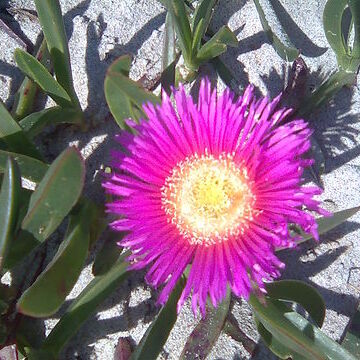Stems spreading, prostrate, to 2 m long. Leaves 3.5–9 cm long, 5–12 mm wide, bright green or grey-green, sometimes tinged red; adaxial surface concave or flat; lateral surfaces flat or barely concave; keel denticulate along entire length or only upper portion. Flowers 3.5–8 cm diam.; pedicels 5–40 mm long. Petal-like staminodes purple, paling near base but not white, streaked when dry; stamens 150–550, 4–6-seriate. Styles 6–14, free; ovary conical, laterally compressed, 2-ridged; ovary concave on top.
A fleshy plant which keeps growing from year to year. It grows about 30 cm high but spreads about 1 m wide. The stems are stout and lie along the ground. They develop suckers. The leaves are succulent and opposite. The leaves are triangle shaped in cross section. They are greyish-green. Leaves can be 9 cm long. The flowers are large. They are pinkish-purple. They occur singly on short stalks between the 2 end leaves. The fruit are fleshy and edible.

